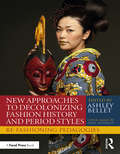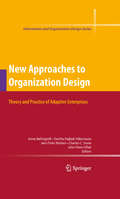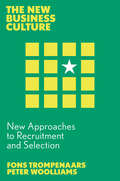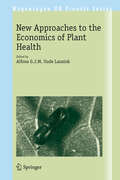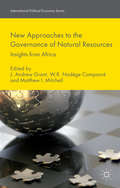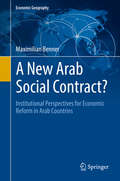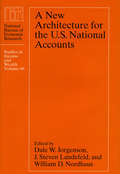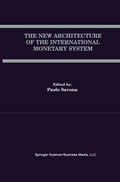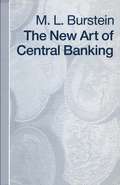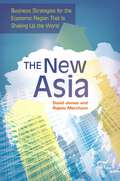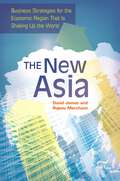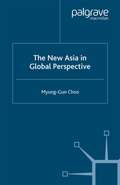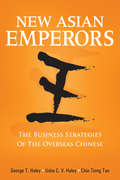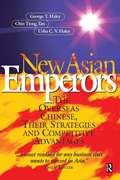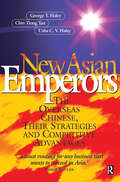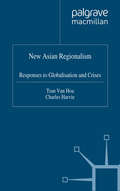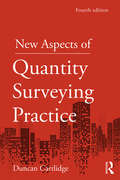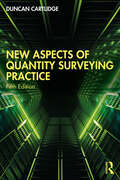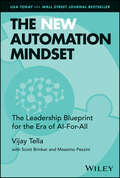- Table View
- List View
New Approaches to Decolonizing Fashion History and Period Styles: Re-Fashioning Pedagogies
by Ashley BelletNew Approaches to Decolonizing Fashion History and Period Styles: Re-Fashioning Pedagogies offers a wide array of inclusive, global, practical approaches for teaching costume and fashion history. Costume designers, technicians, and historians have spent the last several years re-evaluating how they teach costume and fashion history, acknowledging the need to refocus the discourse to include a more global perspective. This book is a collection of pedagogical methods aimed to do just that, with an emphasis on easy reference, accessible activities, and rubrics, and containing a variety of ways to restructure the course. Each chapter offers a course description, syllabus calendar, course objectives, and learning outcomes, as well as sample activities from instructors across the country who have made major changes to their coursework. Using a combination of personal narratives, examples from their work, bibliographies of helpful texts, and student responses, contributors suggest a variety of ways to decolonize the traditionally Western-focused fashion history syllabus. This collection of pedagogical approaches is intended to support and inspire instructors teaching costume design, costume history, fashion history, period styles, and other aesthetic histories in the arts.
New Approaches to Decolonizing Fashion History and Period Styles: Re-Fashioning Pedagogies
New Approaches to Decolonizing Fashion History and Period Styles: Re-Fashioning Pedagogies offers a wide array of inclusive, global, practical approaches for teaching costume and fashion history. Costume designers, technicians, and historians have spent the last several years re-evaluating how they teach costume and fashion history, acknowledging the need to refocus the discourse to include a more global perspective. This book is a collection of pedagogical methods aimed to do just that, with an emphasis on easy reference, accessible activities, and rubrics, and containing a variety of ways to restructure the course. Each chapter offers a course description, syllabus calendar, course objectives, and learning outcomes, as well as sample activities from instructors across the country who have made major changes to their coursework. Using a combination of personal narratives, examples from their work, bibliographies of helpful texts, and student responses, contributors suggest a variety of ways to decolonize the traditionally Western-focused fashion history syllabus. This collection of pedagogical approaches is intended to support and inspire instructors teaching costume design, costume history, fashion history, period styles, and other aesthetic histories in the arts.
New Approaches to Organization Design: Theory and Practice of Adaptive Enterprises (Information and Organization Design Series #8)
by Anne Bøllingtoft Dorthe Døjbak Håkonsson Jørn Flohr Nielsen Charles C. Snow John UlhøiOrganization design is a key feature of management theory and practice. It addresses the challenges of constructing and maintaining effective organizations. Essential to organizational design is the assumption that it can improve organizations. Faced with the ever-accelerating pace of technological change and the restructuring of markets, many firms have been questioning their own organization. This book is the third to emerge from a series of workshops on organization design, featuring new empirical research and theoretical insights. The chapters are organized around four central themes: 1) Towards New Organizational Forms, 2) Dynamics of Adaptation and Change, 3) Theoretical and Practical issues, 4) Fit and Performance. Collectively, the chapters reflect the state of the art of OD as well as provide a further step towards the evolution of this important field of research.
New Approaches to Recruitment and Selection (The New Business Culture)
by Fons Trompenaars Peter WoolliamsCurrent recruitment and selection practices are essentially a cloning process which seeks to match applicants with the current corporate culture of the hiring organisation. This ignores applicants with different points of view, differing value systems and career aspirations. Authors Fons Trompenaars and Peter Woolliams explore the idea that, while all organisations should develop and promote their core values, the application of them needs to be revisited. New Approaches to Recruitment and Selection presents a new framework that compares current corporate cultures with the evolving value systems of current and potential employees. The authors believe that applicants should match the organization’s needs and explore how different categories of applicants can enrich the organisation whilst providing full engagement. The authors’ longitudinal research on traditional frameworks and practices shows that while companies strive to be objective, they are rarely free of cultural bias. They identify serious shortcomings in how organisations utilise their people. While most organisations are implementing a wide range of policies and programmes to identify and eliminate pay inequalities, and improve their attractiveness to women and minorities, great change has not materialised. Each volume in this series will explore failing established models and propose new conceptual frameworks with practical approaches. International case studies enrich the arguments and findings. Purchase of this book includes exclusive access to app-based content, enabling readers to explore the application of specific concepts in further detail.
New Approaches to Recruitment and Selection (The New Business Culture)
by Fons Trompenaars Peter WoolliamsCurrent recruitment and selection practices are essentially a cloning process which seeks to match applicants with the current corporate culture of the hiring organisation. This ignores applicants with different points of view, differing value systems and career aspirations. Authors Fons Trompenaars and Peter Woolliams explore the idea that, while all organisations should develop and promote their core values, the application of them needs to be revisited. New Approaches to Recruitment and Selection presents a new framework that compares current corporate cultures with the evolving value systems of current and potential employees. The authors believe that applicants should match the organization’s needs and explore how different categories of applicants can enrich the organisation whilst providing full engagement. The authors’ longitudinal research on traditional frameworks and practices shows that while companies strive to be objective, they are rarely free of cultural bias. They identify serious shortcomings in how organisations utilise their people. While most organisations are implementing a wide range of policies and programmes to identify and eliminate pay inequalities, and improve their attractiveness to women and minorities, great change has not materialised. Each volume in this series will explore failing established models and propose new conceptual frameworks with practical approaches. International case studies enrich the arguments and findings. Purchase of this book includes exclusive access to app-based content, enabling readers to explore the application of specific concepts in further detail.
New Approaches to the Economics of Plant Health (Wageningen UR Frontis Series #20)
This book presents the outcomes of a workshop around the emerging area of the economics of plant health. The workshop was organized in Wageningen in July 2005 under the auspices of Frontis – Wageningen International Nucleus for Strategic Expertise. Plant health nowadays plays an increasing role in national and international policy making. This explains the interest of the Netherlands Ministry of Agriculture, Nature and Food Quality in this workshop. The increasing importance of plant health in international policy making also follows from the recent establishment of a scientific panel on plant health by the European Food Safety Authority. This panel has to advise the EU on policy issues in the area of plant health. Plant health issues have numerous economic dimensions. Measures to control quarantine diseases and invasive species are usually costly, whereas the potential benefits, e. g. , avoided losses, are often difficult to quantify. Quantifying the costs and benefits requires close collaboration between economists and epidemiologists. New GIS tools can play an important role in visualizing and modelling the combined economic and epidemiological consequences of control measures. Quarantine organisms and invasive species also frequently have impacts that go beyond agriculture. Impacts on landscapes and the environment call for the application of new approaches to measuring the economic impacts on society. This book presents a number of new approaches to economic modelling of plant health; it is primarily intended for policy makers and scientists working in the area of plant health.
New Approaches to the Governance of Natural Resources: Insights from Africa (International Political Economy Series)
by J. Andrew Grant W.R. Nad�ge Compaor� Matthew I. MitchellThe book provides an in-depth analysis of the governance of Africa's natural resource sectors (oil, biofuels, forestry, fisheries, minerals) and new insights for readers as they navigate the burgeoning research on global governance initiatives and regional/national strategies that seek to improve the governance of the continent's natural resources.
A New Arab Social Contract?: Institutional Perspectives for Economic Reform in Arab Countries (Economic Geography)
by Maximilian BennerThis monograph offers a unique conceptual bridge between economic geography and Middle Eastern political economy. Arab economies are confronted with enormous structural difficulties such as high rates of youth unemployment in a challenging demographic context, exacerbated by intense spatial disparities. These structural problems demonstrate the breakdown of the "Arab social contract", a social arrangement centered on a strong role of the state in welfare and employment provision, for which regimes demanded acquiescence to authoritarian rule. The book argues that the Arab social contract can be understood in terms of regulation theories known in economic geography and sociology. It uses the approaches such as the regulation school, national systems of innovation, social systems of production, and varieties of capitalism to analyze the structural difficulties of Arab economies and current reform efforts. The basic assumption is that Arab economies are currently faced with a structural crisis. After the breakdown of the Arab social contract, there is a mismatch between the economic and institutional spheres of society. The challenge is for Arab societies to develop new forms of socio-institutional regulation. The book proposes ways towards such new modes of regulation by developing a framework for regulation specifically targeted towards Arab societies, and by applying it to the cases of Tunisia and Jordan.
A New Architecture for the U.S. National Accounts (National Bureau of Economic Research Studies in Income and Wealth #66)
by Conference on Research in Income and Wealth.A New Architecture for the U.S. National Accounts brings together a distinguished group of contributors to initiate the development of a comprehensive and fully integrated set of United States national accounts. The purpose of the new architecture is not only to integrate the existing systems of accounts, but also to identify gaps and inconsistencies and expand and incorporate systems of nonmarket accounts with the core system. Since the United States economy accounts for almost thirty percent of the world economy, it is not surprising that accounting for this huge and diverse set of economic activities requires a decentralized statistical system. This volume outlines the major assignments among institutions that include the Bureau of Economic Analysis, the Bureau of Labor Statistics, the Department of Labor, the Census Bureau, and the Governors of the Federal Reserve System. An important part of the motivation for the new architecture is to integrate the different components and make them consistent. This volume is the first step toward achieving that goal.
A New Architecture for the U.S. National Accounts (National Bureau of Economic Research Studies in Income and Wealth #66)
by Conference on Research in Income and Wealth.A New Architecture for the U.S. National Accounts brings together a distinguished group of contributors to initiate the development of a comprehensive and fully integrated set of United States national accounts. The purpose of the new architecture is not only to integrate the existing systems of accounts, but also to identify gaps and inconsistencies and expand and incorporate systems of nonmarket accounts with the core system. Since the United States economy accounts for almost thirty percent of the world economy, it is not surprising that accounting for this huge and diverse set of economic activities requires a decentralized statistical system. This volume outlines the major assignments among institutions that include the Bureau of Economic Analysis, the Bureau of Labor Statistics, the Department of Labor, the Census Bureau, and the Governors of the Federal Reserve System. An important part of the motivation for the new architecture is to integrate the different components and make them consistent. This volume is the first step toward achieving that goal.
The New Architecture of the International Monetary System
by Paolo SavonaTwo years ago, the Guido Carli Association, in collaboration with the Aspen Institute Italia, charged a group of distinguished economists to examine the problems created by the unsatisfactory functioning of the International Monetary System. The two resulting conferences were sponsored by the Fondazione della Cassa di Risparmio di Firenze (CESIFIN) and the Permanent Advisory Committee on the Euro and the Dollar (PACE&D). Their research had a two-fold aim. The first was an examination of the basic function of the International Monetary System with a special focus on the role the Euro would and should have. The second was the preparation of a list of recommendations on how to resolve the problems, financial problems in particular, affecting the entire world community. Last year, the group focused on efforts taking place in diverse financial institutions and universities to construct what has been called the `New International Financial Architecture'. This group considered the legal problems arising from European and international integration and, more generally, from the new architecture of the International Monetary System. This book, The New Architecture of the International Monetary System, is the final result of their efforts. It will be an invaluable resource for academics, professionals, and students alike.
The New Art of Central Banking
by M L BursteinCentral banking is being turned upside down by innovations such as securitization, complex options dealings and Euro-asset transactions that are denationalizing money and making it impossible for central banks to regulate costs of capital. Nor can central banks modulate business cycles in open economies; study of banking policy and business fluctuations suggests that the 'real' importance of bank-credit changes has long been exaggerated. The new art of central banking may culminate in masterly inactivity.
The New Asia: Business Strategies for the Economic Region That Is Shaking Up the World
by David L. James Rajeev MerchantThe world's economic center is increasingly shifting from North America and Europe to Asia. This timely guide will provide businesspeople with the knowledge and understanding necessary to remain competitive—and proactive—in that brave new world.To help readers better grasp the causes and effects of the ongoing tectonic shift in economic power, this book examines the 16 nations driving the explosive economic growth of Asia. It shows readers how to apply a "Five Factors" analysis to predict which Asian countries and industries will experience the most vibrant economic growth in coming years—and which will present the greatest risks for international businesses. It then goes a step further, offering insights and strategies that will help businesses assess opportunities in Asia and achieve success there in the years ahead.To help readers make those judgments, this comprehensive, practical resource includes insightful descriptions of the value systems, business practices, customs, and social characteristics of Asia and of individual Asian nations. It also exposes the intra-regional relationships of Asian countries that contribute to, or undermine, their individual economic potential and that of the region as a whole.
The New Asia: Business Strategies for the Economic Region That Is Shaking Up the World
by David L. James Rajeev MerchantThe world's economic center is increasingly shifting from North America and Europe to Asia. This timely guide will provide businesspeople with the knowledge and understanding necessary to remain competitive—and proactive—in that brave new world.To help readers better grasp the causes and effects of the ongoing tectonic shift in economic power, this book examines the 16 nations driving the explosive economic growth of Asia. It shows readers how to apply a "Five Factors" analysis to predict which Asian countries and industries will experience the most vibrant economic growth in coming years—and which will present the greatest risks for international businesses. It then goes a step further, offering insights and strategies that will help businesses assess opportunities in Asia and achieve success there in the years ahead.To help readers make those judgments, this comprehensive, practical resource includes insightful descriptions of the value systems, business practices, customs, and social characteristics of Asia and of individual Asian nations. It also exposes the intra-regional relationships of Asian countries that contribute to, or undermine, their individual economic potential and that of the region as a whole.
The New Asia in Global Perspective
by M. ChooThe remarkable economic growth of Asia has been the defining feature of the second half of this century. This book offers a comprehensive overview of the scientific, technological and economic factors which enabled Asia to make such a strong comeback after centuries of oppression. This historical survey offers useful lessons for the future, and guides predictions for how Asia might face up to the new challenges of the next millennium.
New Asian Emperors: The Business Strategies of the Overseas Chinese
by George T. Haley Usha C. Haley ChinHwee TanSoutheast Asia has a population of more than half a billion, yet its economy is dominated by about 40 families, most of Overseas Chinese descent. Their conglomerates span sectors as diverse as real estate, telecommunications, hotels, industrial goods, computers and sugar plantations. New Asian Emperors shows how and why Overseas Chinese companies continue to dominate the region and have extended their reach in East Asia, despite the Asian financial and SARS crises of the past decade. The authors base their conclusions on in-depth structured interviews spanning a decade with the often elusive Overseas Chinese CEOs including Li Ka-shing, Stan Shih, Victor Fung, Stephen Riady and Sukanto Tanoto, as well as on the strategic information that their companies use. The analysis of the New Asian Emperors’ present-day management techniques and practices draws on the history, culture and philosophical perspectives of the Overseas Chinese in Southeast Asia. In the midst of today’s global economic crisis, this book also takes a fresh look at the role and management practices of the Overseas Chinese as they continue to create some of Asia’s wealthiest and most successful companies. New Asian Emperors explains: The sources and characteristics of Overseas Chinese management Whether Overseas Chinese management practices will spread in the same way that Japanese management did in the 1970s Whether Western management technologies have found themselves outmaneuvered in Asia’s post-crisis arena The Overseas Chinese managers’ strategies for the informational black hole of Southeast Asia and what Western managers can learn from them The New Asian Emperors’ unique strategic perspectives and management styles revealed through exclusive, in-depth interviews The implications for successfully co-operating and competing with the Overseas Chinese of Southeast Asia New Asian Emperors offers key insights into the Overseas Chinese and the important role that cultural roots play in their dominance of Southeast Asian business.
New Asian Emperors
by George Haley Chin Tiong Tan Usha C HaleyMuch has been written about the rise of the Asian economies in recent decades, and their coming economic dominance in the next century. The New Asian Emperors shows how and why overseas Chinese companies are achieving dominance in the Asia Pacific. In the wake of the Asian Currency crisis, this book takes a fresh look at the role of the overseas Chinese as they continue to create some of Asia's most wealthy and successful companies. In particular, the authors tackle the principal difference between Western and Eastern business practices. The overseas Chinese, due to their origins and history developed a unique form of management - now they maintain it as their competitive advantage. Although Asian governments are currently floundering, the overseas Chinese networks continue to prosper. The authors explain the following to Eastern and Western managers:the sources and characteristics of overseas Chinese management,how to combat the overseas Chinese,the strengths and exploitable weaknesses of the overseas Chinese,whether overseas Chinese management practices will spread in the same way as Japanese management did,whether Western management technologies will find themselves outclassed.A feature of the book are the exclusive, in-depth interviews with the New AsianEmperors since most of them avoid the press and little is known of them.
New Asian Emperors: The Business Strategies Of The Overseas Chinese
by George Haley Chin Tiong Tan Usha C HaleyMuch has been written about the rise of the Asian economies in recent decades, and their coming economic dominance in the next century. The New Asian Emperors shows how and why overseas Chinese companies are achieving dominance in the Asia Pacific. In the wake of the Asian Currency crisis, this book takes a fresh look at the role of the overseas Chinese as they continue to create some of Asia's most wealthy and successful companies. In particular, the authors tackle the principal difference between Western and Eastern business practices. The overseas Chinese, due to their origins and history developed a unique form of management - now they maintain it as their competitive advantage. Although Asian governments are currently floundering, the overseas Chinese networks continue to prosper. The authors explain the following to Eastern and Western managers:the sources and characteristics of overseas Chinese management,how to combat the overseas Chinese,the strengths and exploitable weaknesses of the overseas Chinese,whether overseas Chinese management practices will spread in the same way as Japanese management did,whether Western management technologies will find themselves outclassed.A feature of the book are the exclusive, in-depth interviews with the New AsianEmperors since most of them avoid the press and little is known of them.
New Asian Regionalism: Responses to Globalisation and Crises
by Tran Van Hoa C. HarvieThis collection of selected studies by well-known experts in major Asian countries surveys, discusses and analyzes emerging problems and challenges facing them. It proposes prescriptions for better regional economic integration and more effective economic management in the future. The book's area of study includes economics and business development, development economics, trade and investment, global competitiveness economics policy in Asia, globalisation, the WTO, and regional and international economic integration.
New Aspects of Quantity Surveying Practice
by Duncan CartlidgeIn this fourth edition of New Aspects of Quantity Surveying Practice, renowned quantity surveying author Duncan Cartlidge reviews the history of the quantity surveyor, examines and reflects on the state of current practice with a concentration on new and innovative practice, and attempts to predict the future direction of quantity surveying practice in the UK and worldwide. The book champions the adaptability and flexibility of the quantity surveyor, whilst covering the hot topics which have emerged since the previous edition’s publication, including: the RICS ‘Futures’ publication; Building Information Modelling (BIM); mergers and acquisitions; a more informed and critical evaluation of the NRM; greater discussion of ethics to reflect on the renewed industry interest; and a new chapter on Dispute Resolution. As these issues create waves throughout the industry whilst it continues its global growth in emerging markets, such reflections on QS practice are now more important than ever. The book is essential reading for all Quantity Surveying students, teachers and professionals. It is particularly suited to undergraduate professional skills courses and non-cognate postgraduate students looking for an up to date understanding of the industry and the role.
New Aspects of Quantity Surveying Practice: A Text For All Construction Professionals
by Duncan CartlidgeIn this fourth edition of New Aspects of Quantity Surveying Practice, renowned quantity surveying author Duncan Cartlidge reviews the history of the quantity surveyor, examines and reflects on the state of current practice with a concentration on new and innovative practice, and attempts to predict the future direction of quantity surveying practice in the UK and worldwide. The book champions the adaptability and flexibility of the quantity surveyor, whilst covering the hot topics which have emerged since the previous edition’s publication, including: the RICS ‘Futures’ publication; Building Information Modelling (BIM); mergers and acquisitions; a more informed and critical evaluation of the NRM; greater discussion of ethics to reflect on the renewed industry interest; and a new chapter on Dispute Resolution. As these issues create waves throughout the industry whilst it continues its global growth in emerging markets, such reflections on QS practice are now more important than ever. The book is essential reading for all Quantity Surveying students, teachers and professionals. It is particularly suited to undergraduate professional skills courses and non-cognate postgraduate students looking for an up to date understanding of the industry and the role.
New Aspects of Quantity Surveying Practice: Fourth Edition
by Duncan CartlidgeThe construction industry is undergoing great change particularly with the introduction of digital technologies and the increasing emphasis on sustainability and ethical practice. The fifth edition of New Aspects of Quantity Surveying Practice introduces and discusses these changes and their impact on the industry. The book champions the adaptability and flexibility of the quantity surveyor, whilst covering the hot topics which have emerged since the previous edition’s publication, including: • A new chapter on the impact of digital construction • Sustainable construction • Procurement trends • Ethics and ethical practice • The RICS Futures (2020) publication The book is essential reading for all quantity surveying students, teachers and professionals. It is particularly suited to undergraduate professional skills courses and non-cognate postgraduate students looking for an up to date understanding of the industry and the role.
New Aspects of Quantity Surveying Practice
by Duncan CartlidgeThe construction industry is undergoing great change particularly with the introduction of digital technologies and the increasing emphasis on sustainability and ethical practice. The fifth edition of New Aspects of Quantity Surveying Practice introduces and discusses these changes and their impact on the industry. The book champions the adaptability and flexibility of the quantity surveyor, whilst covering the hot topics which have emerged since the previous edition’s publication, including: • A new chapter on the impact of digital construction • Sustainable construction • Procurement trends • Ethics and ethical practice • The RICS Futures (2020) publication The book is essential reading for all quantity surveying students, teachers and professionals. It is particularly suited to undergraduate professional skills courses and non-cognate postgraduate students looking for an up to date understanding of the industry and the role.
The New Automation Mindset: The Leadership Blueprint for the Era of AI-For-All
by Vijay Tella Scott Brinker Massimo PezziniExplore the true potential and impact of business automation Digital transformation of the business landscape is well underway, and businesses are being reshaped faster than ever before. Agility and adaptability are now critical components of these business' survival. But building these traits requires a holistic approach with an unrelenting focus on automation. How does one go about developing that focus? In The New Automation Mindset: The Leadership Blueprint for the Era of AI-for-All, renowned entrepreneur and tech strategists Vijay Tella, Scott Brinker, and Massimo Pezzini deliver a guide to implementing automation in the real world, avoiding jargon and vague bromides in favor of concrete examples of the successful integration of automated technologies and descriptions of the positive results they had on the companies that deployed them. In the book, you'll also find: Hands-on advice for C-suite executives, front-line managers, and everyday employees to implement effective automation frameworks Insightful explorations of the innovation and growth advantages of automation Deep treatments of how automation is about more than just RPA—or Robotic Process Automation—and efficiency An inspiring and practical presentation of one of the most essential topics in business today, The New Automation Mindset will earn a place on the bookshelves of founders, entrepreneurs, managers, shareholders, tech enthusiasts, knowledge workers, and anyone else with an interest in digital transformation and commerce.
The New Automation Mindset: The Leadership Blueprint for the Era of AI-For-All
by Vijay Tella Scott Brinker Massimo PezziniExplore the true potential and impact of business automation Digital transformation of the business landscape is well underway, and businesses are being reshaped faster than ever before. Agility and adaptability are now critical components of these business' survival. But building these traits requires a holistic approach with an unrelenting focus on automation. How does one go about developing that focus? In The New Automation Mindset: The Leadership Blueprint for the Era of AI-for-All, renowned entrepreneur and tech strategists Vijay Tella, Scott Brinker, and Massimo Pezzini deliver a guide to implementing automation in the real world, avoiding jargon and vague bromides in favor of concrete examples of the successful integration of automated technologies and descriptions of the positive results they had on the companies that deployed them. In the book, you'll also find: Hands-on advice for C-suite executives, front-line managers, and everyday employees to implement effective automation frameworks Insightful explorations of the innovation and growth advantages of automation Deep treatments of how automation is about more than just RPA—or Robotic Process Automation—and efficiency An inspiring and practical presentation of one of the most essential topics in business today, The New Automation Mindset will earn a place on the bookshelves of founders, entrepreneurs, managers, shareholders, tech enthusiasts, knowledge workers, and anyone else with an interest in digital transformation and commerce.
